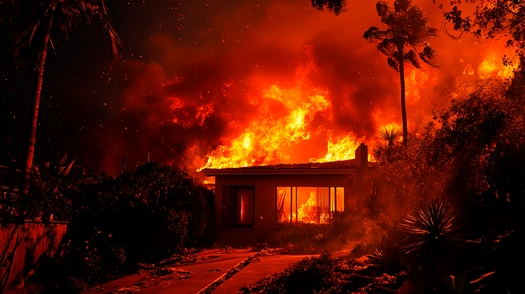The true cost of fossil fuel production

How to protect California communities and taxpayers from the devastation that the new norm of extreme weather causes.
For far to long fossil fuel companies have polluted the planet without any apparent regard to what their products do to the environment. There is documented evidence that the biggest of these corporations had knowledge of how dangerous continued use of fossil fuels would be for human health. The U.N. has stated we must stop this pollution if we want to mitigate the extreme weather that has been caused by this pollution. California communities are under siege by escalating fires, floods, droughts, and other disasters. From 1980–2024, 46 extreme weather and climate disaster events impacted California, with losses exceeding $1 billion each.
As the world saw vast areas of Los Angeles and Ventura Counties burn in January 2025 the reality of the level of destruction that a warming planet can inflict hit home. Globally, just 57 companies are attributed with 80% of planet-heating pollution. Yet these companies rake in billions every year. Chevron, for example, put away $30 billion in profits in 2023. Meanwhile, California is facing a budget shortfall of $32 billion and growing after the L.A. fires — which killed 29 people and burned over 18,000 structures, according to NBC News.
Fires are getting worse because of rising temperatures. Yet those responsible for the lion’s share of that rise are “desperately trying to avoid accountability,” said former Culver City mayor Meghan Sahli-Wells, in the Guardian. “Accountability is an existential threat to their business model, and their business model is an existential threat to all of us.”
Californians and the state have been saddled with massive bills for climate disasters. Cities and counties have had to pick up the tab for the costs of climate destruction, stretching scarce local resources.
California is the forth largest economy in the world. It may be possible to make these polluters pay for the damages. New York passed a climate superfund bill in December 2024, following Vermont.




The Public Health Damage
EOPA California urges action from Gov. Newsom to protect the health of all Californians on our way to 100% clean energy. If you are a current or former CA elected official please sign join over 500 of your fellow elected officials who have signed our letter HERE.
The evidence is in – we know exposure to toxic air contaminants and other pollution caused by oil and gas wells is a significant threat to public health, and disproportionately affects disadvantaged communities.1
The state of California has found that the most significant health impacts occur within one half mile of oil and gas drilling. According to the California Council on Science and Technology, the greatest health risks occur within one-half mile from active oil and gas development,7 yet nearly 8,500 active California oil and gas wells are within 2,500 feet of homes, schools, and hospitals.8
California only enacted a statewide policy limiting the proximity of new oil and gas wells to homes and vulnerable areas like schools, parks, and hospitals in 2022 by 3,200 feet. But as of December of 2022, there is a challenge to the law with a public referendum, which collected signatures unlawfully. EOPA California continues to fight for those safety setbacks and to have them encompass all existing oil and gas wells.
The globe is heating up -
Oil and gas drilling in California contributes to global warming on land or in the ocean deepens. It harms our air, water and land and the lives of all Californians:
Production of oil and gas is a significant contributor to California’s greenhouse gas emissions,2 with particulates polluting the air we breathe.
Three-quarters of California’s oil production is as dirty as Canada’s tar sands crude for the climate.3
The public health and climate impacts of fossil fuels already cost Californians more than 12,000 lives and one hundred billion dollars annually.4
The oil and gas industry contributes less than 0.3 percent of California’s GDP and a small number of jobs.5, 6
1. Srebotnjak, Tanja and Miriam Rotkin-Ellman, “Drilling in California: Who’s at risk?,” Natural Resources Defense Council, October 2014, p. 4. https://www.nrdc.org/sites/default/files/california-fracking-risks-report.pdf
2. California Air Resources Board, “California’s 2017 Climate Change Scoping Plan,” November 2017, p. 7. https://www.arb.ca.gov/cc/scopingplan/scoping_plan_2017.pdf?_ga=2.253665481.1304555220.1515158610-304097323.1509477659
3. Oil Stain. How Dirty Crude Undercuts California’s Climate Progress. Center for Biological Diversity. November 2017. https://www.biologicaldiversity.org/programs/climate_law_institute/energy_and_global_warming/pdfs/Oil_Stain.pdf
4. Jacobson, Mark Z. et al. “A roadmap for repowering California for all purposes with wind, water, and sunlight.” Energy (2014). https://web.stanford.edu/group/efmh/jacobson/Articles/I/CaliforniaWWS.pdf
5. U.S. Bureau of Economic Analysis, “Gross domestic product (GDP) by state (millions of current dollars),” January 24, 2018. https://www.bea.gov/iTable/index_regional.cfm
6. U.S. Bureau of Labor Statistics (BLS) and California Employment Development Department’s (EDD) Labor Market Information Division, “Quarterly Census of Employment and Wages: Industry Information,” industry codes 211 (Oil and gas extraction) and 213 (Support activities for mining), accessed April 2018. https://data.edd.ca.gov/Industry-Information-/Quarterly-Census-of-Employment-and-Wages-QCEW-/fisq-v939
7. California Council on Science and Technology (CCST), “An Independent Scientific Assessment of Well Stimulation in California: An Examination of Hydraulic Fracturing and Acid Stimulations in the Oil and Gas Industry – Summary Report, “ July 2015, p. 63. https://ccst.us/publications/2015/2015SB4summary.pdf
8. Oil Change International. The Sky’s Limit California: Why the Paris Climate Goals Demand that California Lead in a Managed Decline of Oil Extraction. May 2018. http://priceofoil.org/content/uploads/2018/05/Skys_Limit_California_Oil_Production_R2.pdf
